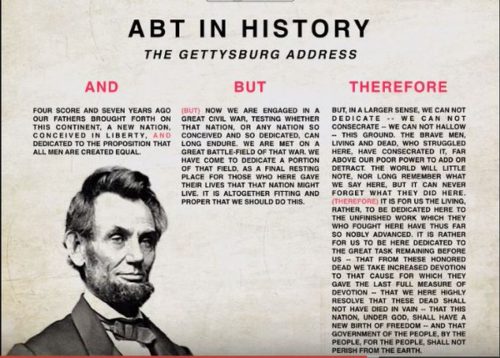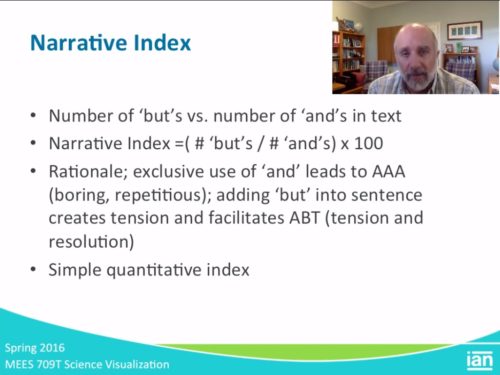Story telling tools - The history of communicating well
Melissa Merritt ·Melissa Merritt
Have you ever wondered if there's a secret formula for how to speak more effectively? A consistent method that can be used across the board to frame any presentation? Well the key sounds pretty simple. Tell a story.

A story doesn't sound too difficult to create. Tell a story to gain an audience's investment and understanding of the information you're presenting. The framework for telling a story includes: And, But, Therefore (ABT). Three basic words that help to set up the background, create the conflict, and finish with a resolution. You begin with a story. You allow people to become familiar with the story. But something changes in this story that creates a situation that needs resolved! Therefore, your speech needs to finish with a solution for that situation. This is very straightforward, very practical. Very easy.
But then again, maybe not.
Developing a narrative in this ABT style was the focus of the second week of the Science Visualization Course offered through IAN. As participants in the class, we were charged with creating a simple ABT statement about any work that we were doing. This was an assignment that would translate to no more than a paragraph, tops. Quite honestly, it's not hard to write-up an ABT statement, to write three to four sentences that contains 'and, but, therefore' in them. But writing an ABT statement that captures the audience's attention and makes sense, is.

The class started with a discussion of what made effective presentations in the past. What makes a memorable presentation? Besides the elements of enthusiasm and knowledge of the speaker, it turns out structure- structure that followed the ABT framework- played a consistent role in the success of great leaders' speeches: Lincoln, Darwin, even Nobel Peace Prize lecturers. Memorable leaders capitalized on creating tension through storytelling elements shaped by ABT elements. A strong example included Abraham Lincoln's Gettysburg Address. Bill Dennison, the primary instructor for the class, reviewed the concept he helped to create of "narrative index" in order to understand what exactly made Abraham Lincoln's speech so effective. The narrative index includes a count of the number of 'but's' vs the number of 'and's' in the speech text. The idea is that the more 'but's there are in the sentence, the more tension that is created, allowing the ABT structure to unfold with a resolution at the end. The higher the narrative index, the more effective the presentation. Abraham Lincoln's two minute Gettysburg Address had a narrative index of 33. To put this in perspective, Edward Everett, a prominent politician who was considered one of the best orators of the country at the time, produced a two HOUR long speech given right before Lincoln's that had a narrative index of 8.
Abraham Lincoln's Gettysburg address. On that day, two people spoke at the dedication of the cemetery of Gettysburg, Pennsylvania. Edward Everett's Gettysburg Address: 13,581 words. Abraham Lincoln's: 272 words.
It seems however, that the idea of storytelling might get lost in the sciences. This point was brought up consistently during class, that scientists are of the impression that data alone can persuade an audience. But it turns out, data is not enough without a story. Enter our own ABT statements. No one's statement made it through review in class unscathed. As our instructors, Bill Dennison and Bill Nuttle, reviewed each and every one of our statements, a few themes became apparent. The beginning of the ABT statements, the facts that set up the narrative, need to be just as compelling as the final statements. Generalizations were not as convincing as statements with data to back them up. Bill Nuttle, helped to flesh out one final main theme that included understanding the audience. Each of our statements could have been rewritten or edited differently, based on the audience we aimed to engage. Bill Nuttle further discussed how to involve the audience through storytelling, by making sure to build on shared values, while making sure that a wide range of solutions are constantly under review.

The bottom line is, these statements are KEY to effective communication. Their structure, with a succinct conflict and resolution framework, creates the most memorable method to deliver facts and information. But, these short statements take time to create, and in fact can prove to be harder to produce than writing multiple paragraphs of the same information. Therefore, it is imperative that time is taken to craft these statements, with care in word choice, to make them meaningful statements. As Bill Dennison summarized in his presentation, "The story is in the data, and we have to figure out how to tell that story."
Next Post > Combating climate change in the floating city
Comments
-
Liz Myers 8 years ago
I agree that creating succinct, engaging, meaningful ABT statements takes time and skill. Scientists may be especially challenged in using this narrative structure because their training emphasizes communication with a fairly narrow audience: other scientists in the same field. For this audience of peers, simplicity (succinctness) is not highly valued, and the author can assume that the key audience shares a knowledge base (so important contextual information is often omitted). Moreover, the standard structure of scientific articles (Introduction, Method, Results, Discussion) doesn't promote the ABT narrative. But a scientific paper's introductory literature review is one place where the kernel of an intriguing ABT narrative might lie, since the literature review frames the study in the context of a broader ongoing conversation within the field, thus prompting an author to explain what makes THIS study unique and valuable, and how results can contribute to salient questions in the field.
-
Kristie Gianopulos 8 years ago
Yes, you have set the bar high for everyone else, haha! I love the picture at the beginning, and how you yourself used the ABT format in the 2nd paragraph!
Along with Holly, I too have begun noticing when someone is droning on with "and, and, and" (boring, says Bill Dennison). In writing a final report I'm working on right now, I've revamped part of the intro to include more ABTs. It definitely is helpful to have a template for better communication of science ideas! -
Katie Goerger 8 years ago
"The bottom line is, these statements are KEY to effective communication. Their structure, with a succinct conflict and resolution framework, creates the most memorable method to deliver facts and information...But, ....Therefore..."
-
Holly Padgett 8 years ago
Wow, nice blog! Did you really have to set such a high bar for everyone else?! :-P
I'll admit, I was originally really skeptical of the ABT hype...but now that I've had some practice with it I can definitely see its value. It really forces you to think hard about your subject matter and to figure out why its interesting and then, of course, to communicate it.
I spend a lot of my time trying to figure out and communicate why different science projects are valuable to society. Not only am I starting to notice when other people use a good ABT, but I'm also finding it to be a helpful tool when I'm talking about our projects.
-
Michelle Canick 8 years ago
My initial thought was the same as a few others - way to set the bar high!
The idea from class that I can't get out of my mind is volleyball bump, set, spike as an analogy for ABT story structure. Something about the rhythm of the ball and the rhythm of storytelling really speaks to me.
-
Atika 5 months ago
Thank you for sharing this great information with us, i really appreciate your post!